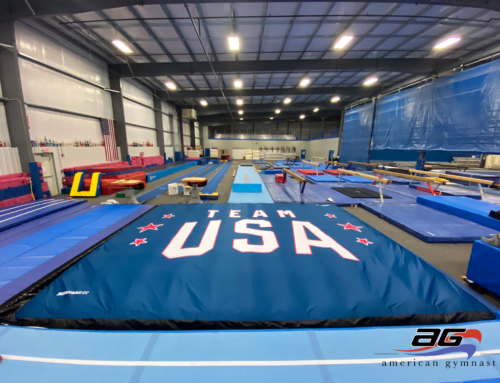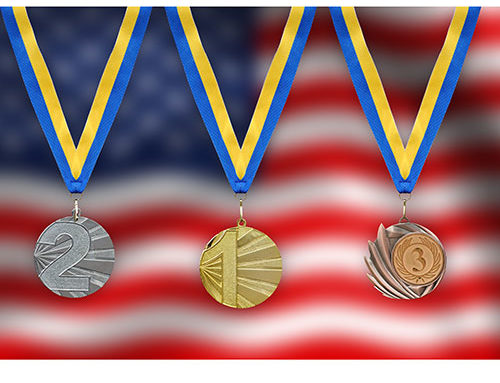It’s early in the Olympic year, and at this point it’s fun to begin to predict who will likely make the U.S. Olympic teams that will be announced in just a few months. After all, how much can possibly change in such a short amount of time? All of the world championships of the quadrennium are complete. We know which gymnasts have proven themselves over the last four years. We know which gymnasts have been on the rise and are now senior age-eligible. We know which gymnasts have suffered major injuries or retired. We know which gymnasts have announced Olympic comebacks. We should be able to predict which gymnasts are most likely to end up on this summer’s Olympic team…right?
Wrong. Unfortunately, as much as we like to believe we can predict what’s going to happen in the few months prior to an Olympic Games, history tells us that we cannot.
Below is a look at many of the surprises that occurred with the selection of the past seven U.S. women’s Olympic teams:
1984: Diane Durham, the 1983 U.S. national all-around champion, was injured at the 1984 Olympic Trials and dropped out of the competition, believing she could later petition onto the Olympic team. She later found out that since she had not competed in the 1983 world championships, her petition would not be allowed. She watched the Los Angeles Olympics from home.
1988: Kristie Phillips, the 1987 U.S. national all-around champion who had graced the cover of Sports Illustrated in 1986 as “The New Mary Lou,” placed a devastating 8th in the final 1988 Olympic Trials standings – less than three tenths behind 6th place Melissa Marlowe. The gymnast who had widely been considered America’s best hope for a medal in Seoul didn’t even make the trip.
1992: Dominique Dawes, who had gained national recognition as a 13-year-old in 1991 for her innovative and dynamic back-to-back tumbling passes, proved she was one of America’s up-and-coming all-around gymnasts in 1992 and ended up on her first Olympic team in Barcelona, Spain. After one of the most controversial Olympic selection procedures in U.S. history that involved separate closed-doors selection camps being held after the formal Olympic Trials, 1989 world team member Wendy Bruce surprisingly ended up on the Olympic team over fellow 1989 world team member Kim Kelly (who had initially believed she made the Olympic team after placing 6th at the Trials) and 1991 world team members Michelle Campi (injured) and Hilary Grivich (weak uneven bars and was harshly scored at the Trials). Another Olympic favorite, veteran Sandy Woolsey, had announced a surprising retirement less than a year before the 1992 Olympic Games after being left off the 1991 world team.
1996: The “Magnificent Seven” that won the legendary gold in Atlanta was perhaps the most predicable Olympic team in recent U.S. history. Although nearly all of them had suffered some type of injury during the year prior to the Olympic Games and had questionable statuses at various times during the Olympic selection process, all seven clearly rose to the top and declared their spots when all was said and done. Several potential challengers did exist, like Kristy Powell, Teresa Kulikowski, Mary Beth Arnold, Jennie Thompson, and Mohini Bhardwaj, but there was no question that, when healthy, the seven who ended up wearing gold around their necks that summer were truly in a league of their own. One surprise was the retirement of 1994 world team member Doni Thompson, who, like Sandy Woolsey four years prior, was a very legitimate contender for the team but bowed out of the race less than a year before the Games.
2000: If the 1996 team was the most predictable team in recent U.S. history, the 2000 team was perhaps the least so. The Games themselves that year in Sydney, Australia were such a fiasco – from the vault controversy, to Andrea Raducan’s all-around gold medal being stripped, to the Chinese team’s bronze medal being transferred to the Americans ten years later – that it’s only fitting that the U.S. Olympic selection process was equally as dramatic. Only two members of that six-woman team – Kristen Maloney and Elise Ray – could have been reliably predicted early in the Olympic year. Jennie Thompson, who in 1999 appeared to be a near-lock for the Olympic team, retired due to back problems in early 2000. Jeanette Antolin, a 1999 world team member who looked to be rising to the top fast, took a downward turn in the Olympic year, had an injury at the U.S. nationals, and ended up 11th at the Olympic Trials. Vanessa Atler, expected throughout the entire quadrennium to be America’s best hope for gold in Sydney, essentially fell apart mentally in the months leading up to the Olympic Games and made several large errors at Trials. Her exclusion from the Olympic team – in not even an alternate position – was one of the most controversial selection decisions in U.S. history. Most wouldn’t have predicted that the talented, yet inconsistent, Jamie Dantzscher would get it together as well as she did that summer just in time to make that Olympic team. Amy Chow, who had announced a comeback in 1999, didn’t look nearly Olympic ready in early 2000, but ended up delivering a sizzling performance at the Olympic Trials and actually ended up with the highest two-day total there en route to making her second Olympic team. Dominique Dawes was the final Magnificent Seven member (of five) to announce an Olympic comeback, which she did just a few months before the Games in Sydney. After having several falls at the U.S. Nationals and appearing to be a long shot at best, she performed consistently at Trials and ended up a surprise addition to her third Olympic team. After Morgan White became unable to compete in Sydney due to a broken foot, a very inexperienced Tasha Schwikert, the youngest gymnast in the Olympic mix, became perhaps the biggest surprise of all. Not only was Tasha named to the team, but she performed more consistently than any of her more experienced teammates in Sydney and was the only American to not suffer any falls throughout the competition. The highly unsuspected and unique mix of gymnasts that resulted did perform quite solidly in the team finals in Sydney, though it perhaps wasn’t appropriately recognized until they were awarded the Olympic team bronze medal a full decade later.
2004: Mohini Bhardwaj made what has to be considered one of the greatest comebacks in sports history that year at age 25. Most wouldn’t have ever considered her a legitimate threat for that Olympic team until she showed up at the Olympic Trials with better form, bigger skills, and more confidence than she had ever shown throughout her entire career. Courtney McCool was a first-year senior with no worlds experience who wouldn’t have likely been considered a real contender for the Olympic team until she turned heads at the 2004 Olympic test event and then placed 2nd at the American Cup with her polished, exquisite gymnastics. Annia Hatch and Courtney Kupets were doubted by many to have enough time to recover from their serious injuries suffered at the 2003 worlds – a torn ACL for Hatch and a torn Achilles for Kupets – but both returned looking stronger than ever at the 2004 nationals. Tasha Schwikert was America’s best in 2001 and 2002 and, despite being a bit beaten up in the two years prior to Athens, was still fully expected to make that Olympic team. Her low scores at Trials and loss of favoritism with Marta Karolyi made her a surprising alternate to the final squad. In addition to Schwikert, three individual world champions were surprisingly left off that Olympic team as well. Hollie Vise and Chellsie Memmel were co-world champions on uneven bars in 2003, and Ashley Postell was the 2002 world beam champion and initially a member of the 2003 world team before getting sick. Vise and Memmel were both recovering from injuries and were considered bars and beam specialists, and Marta’s decision to choose neither of them for that team in favor of two big vaulters (Bhardwaj and Hatch) was quite a surprising move. Postell’s confidence had deteriorated somewhat that year and problems on bars at nationals prevented her from even making the Olympic Trials. She then turned down an offer to replace an injured gymnast at the Trials, choosing instead to prepare for college gymnastics.
2008: Bridget Sloan was the biggest surprise of the U.S. Olympic team in Beijing, particularly after suffering several big mistakes at the Olympic Trials. Many would have expected 2006 world all-around silver medalist Jana Bieger or 2007 world team members Shayla Worley or Ivana Hong to be more likely choices, but it was Sloan who remained healthy and claimed the final spot with a strong performance at the final selection camp. Chellsie Memmel, the 2005 world all-around champion, was also no guarantee for that team after being out of all-around competition for two years and looking less than Olympic ready at the Olympic test event in late 2007. Few would have predicted that Chellsie would look better and more confident than ever by the 2008 Olympic Trials and finally land a spot on her first Olympic team.
Who will soon be added to this list as the 2012 Olympic Surprises? Expect the unexpected in the coming months…history has proven that it’s going to be a wild ride.



It is also worth noting that Mohini Bharwaj’s comeback was due in part to financial sponsorship by Pamela Anderson!